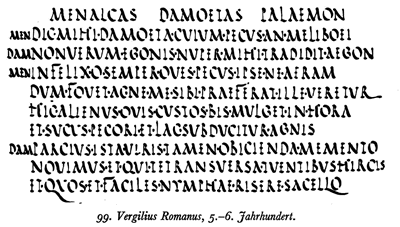|
|
| It is well known that Rome was not built in a day, and the same might be said of the development of Roman calligraphy. Around the 7th century BC the Latin people adopted and expanded the Greek-based alphabet of the Etruscans. The oldest Latin document dates from the 6th century BC - Lapis Niger, the black Forum stone. In ancient times tradition would have it that this revered black marble slab was the tombstone of the mythical city founder, Romulus. |
||
 |
||
|
Etruscan Script, c. 7th century BC.
|
||
| Until the 4th century BC the Romans remained undecided as to their preferred writing direction. At first proceding right-to-left and changing line by line, they gradually moved over to a left-to-right direction only. | ||
| By the end of the first century BC, their alphabet consisted of 21 characters; K, Y and Z were later added to enable the correct spelling of Greek names and loan-words. Z, a very old letter, fell into disuse, then was borrowed back for Greek words. J and V were the consonantal forms of I and U, pronounced in the same way as their vowel counterparts, so they did not require separate letters. | ||

|
||
|
Etruscan Script (PC-TT), digitized by Gabor
|
||
| Did we mention writing? Chiselling and gouging, more like! Our knowledge of Roman letterforms derives from monuments, palaces and columns, their versals hewn in stone for all eternity, without a comma or a full stop. The capitalis romana, the forbear of all Roman type, evolved principally into block capitals, its characters accomodating the basic geometric shapes of circle, square and triangle with unmatched consideration for legibility. | ||
| The scriptura monumentalis was the preferred form for inscriptions in stone. The letters would first be drawn on the stone with a paint-brush, then hollowed out by the stone mason. Precise elaboration of the corners gave rise to the fine serifs. | ||
 |
||
|
|
||
|
|
||
| In the course of metal-working the scriptura actuaria came into use, since engraving with a gouge permitted a smaller and less rigid form, where varying height of the letters and some distortion of the curves was acceptable. | ||
 |
||
| Day-to-day correspondence was not conducted on monuments, however, and the Romans also wrote on parchment, papyrus and wax tablets. Different forms of the Roman capital evolved on these surfaces. The imposing appearance of the capitalis quadrata, the script of poets and thinkers (Virgil) clearly denotes a prestigious script. | ||
|
|
||
| The capitalis rustica however preceded it as the Roman casual hand. Flowing more freely and with greater verve, its letters stand more closely together, and are essentially taller than they are wide. | ||
|
|
||
| For everyday use, the Roman cursive developed from the capitalis, optimised for active business use and correspondence. We know it from wax tablets, fragments of papyrus and graffiti. When Pompei and Herculaneum were excavated they found market traders such as greengrocers had marked the names and prices of their goods on the exterior walls of buildings as graffiti. Also there was graffiti such as we find in toilets today- who loves whom and so on. It is clear from the graffiti that the spoken language was very different in grammar and vocabulary from the classical Latin of Cicero, and already this vulgar Latin was moving towards what would become the Romance languages - principally Italian, Spanish, Catalan, Portuguese, French and Romanian. For instance they had developed words for he, she, it and the definite article, which classical Latin avoids by neat use of word order. | ||
 |
||
|
Old Roman Cursive
|
||
| The Roman scribes tended to slant these letters, particularly with the increased use of papyrus, in order to cope better with the grooved structure of their writing surface. Cursive letters also enabled a faster writing pace, especially when combined with the universally popular ligatures. In addition, a tendency towards curves gradually prevailed over the once straight stems.Between the 4th and 8th century AD the new Roman cursive developed as the customary script for documents. In it we may already discern the shapes of the later minuscules. The letters became subtly differentiated and less uniform. Ascenders emerged more clearly, having simple entry and exit strokes. The use of parchment rather than papyrus promoted the tendency to round letters, as its smooth surface was appreciably more suitable than papyrus for writing clean curves. | ||
|
|
||
| From this developed uncials (uncia literally means one twelfth, hence became our inch and also ounce, originally one twelfth of a Roman pound weight) in which the first bound books were written during the sixth century AD. By this time the Roman Empire had long been history, Pompei long since lost, the last Western Roman Emperor deposed in the 5th century by the Germanic General Odoaker. | ||
| In spite of all that, the Germanic, Norse and Anglo-Saxon runes were unable to withstand the opposition of the Latin script even after the end of the Western Roman Empire. The history of letter-forms during the past 2000 years or so bears witness to the immense success of the Romans in launching the capitalis romana. | ||
 |
||
| Odoaker was digitized from the latest known Roman capitalis, 8th century. | ||
| Now available: | ||
|
Alfabetix by Apostrophe
|
||